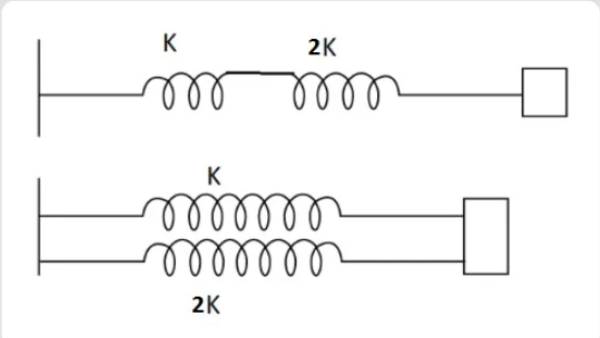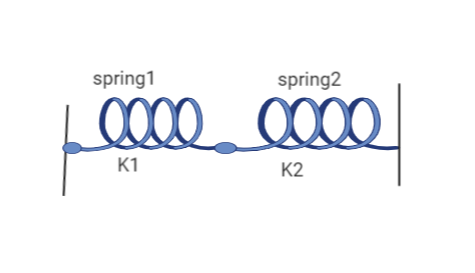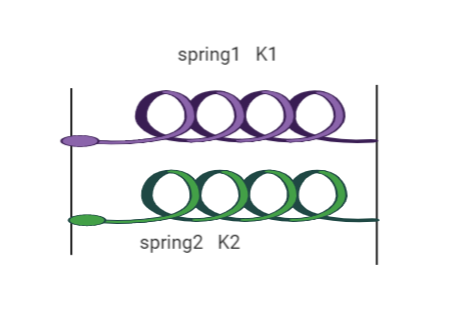
If ${K_i}$ and ${K_p}$ are the effective spring constant in series and parallel combination of springs as shown in figure, find \[\dfrac{{{K_i}}}{{{K_p}}}\].

A. 9/2
B. 3/7
C. 2/9
D. 7/3
Answer
218.7k+ views
Hint: Try to recall the concept of dividing current in branches having resistance \[{R_1}\] and \[{R_2}\] which are firstly connected in series and secondly in parallel. From that concept we will get the idea of adding spring constants, either springs are connected in series or connected in parallel. And then simply take the ratio of and we will get the answer.
Complete step by step answer:
First we will see the concept of adding spring constants when they are connected in
1. Series
2. Parallel
Case:1 When Springs are connected in series.
When two spring are connected in series having spring constants \[{K_1}\] and \[{K_2}\] as shown in below figure

Then the resulting Spring constant ${K_r}$ is given by the formula:
\[\dfrac{1}{{{K_{}}}} = \dfrac{1}{{{K_1}}} + \dfrac{1}{{{K_2}}}\]
Now from the question
\[{K_1} = K\]
\[{K_2} = 2K\]
Putting values in formula
\[\dfrac{1}{{{K_r}}} = \dfrac{1}{K} + \dfrac{1}{{2K}}\]
\[\dfrac{1}{{{K_r}}} = \dfrac{{2K + K}}{{2{K^2}}}\]
\[\dfrac{1}{{{K_r}}} = \dfrac{3}{{2K}}\]
\[{K_r} = \dfrac{{2K}}{3}\]
Case 2: When springs are connected in parallel
When two spring are connected in parallel having spring constants \[{K_1}\] and \[{K_2}\] as shown in below figure

Then the resulting Spring constant \[{K_p}\] is given by the formula:
\[{K_p} = {K_1} + {K_2}\]
Given values of \[{K_1}\] and \[{K_2}\]from question:
\[{K_1} = K\]
\[{K_2} = 2K\]
Putting values in above equation:
\[{K_p} = K + 2K\]
\[{K_p} = 3K\]
Now we have both spring constant
\[\dfrac{{{K_i}}}{{{K_p}}} = \dfrac{{{K_r}}}{{{K_p}}} = \dfrac{{\dfrac{{2K}}{3}}}{{3K}}\]
\[\dfrac{{{K_i}}}{{{K_p}}} = \dfrac{2}{9}\]
Hence, option C is correct.
Note: This concept can be used to combine two springs and replace it with a new one. Not only we are bound to combine two springs we can also combine many strings. If the spring constant of a spring is high then it is difficult to stretch it more while spring having less or low spring constant can be elongated much more than the previous one.
Complete step by step answer:
First we will see the concept of adding spring constants when they are connected in
1. Series
2. Parallel
Case:1 When Springs are connected in series.
When two spring are connected in series having spring constants \[{K_1}\] and \[{K_2}\] as shown in below figure

Then the resulting Spring constant ${K_r}$ is given by the formula:
\[\dfrac{1}{{{K_{}}}} = \dfrac{1}{{{K_1}}} + \dfrac{1}{{{K_2}}}\]
Now from the question
\[{K_1} = K\]
\[{K_2} = 2K\]
Putting values in formula
\[\dfrac{1}{{{K_r}}} = \dfrac{1}{K} + \dfrac{1}{{2K}}\]
\[\dfrac{1}{{{K_r}}} = \dfrac{{2K + K}}{{2{K^2}}}\]
\[\dfrac{1}{{{K_r}}} = \dfrac{3}{{2K}}\]
\[{K_r} = \dfrac{{2K}}{3}\]
Case 2: When springs are connected in parallel
When two spring are connected in parallel having spring constants \[{K_1}\] and \[{K_2}\] as shown in below figure

Then the resulting Spring constant \[{K_p}\] is given by the formula:
\[{K_p} = {K_1} + {K_2}\]
Given values of \[{K_1}\] and \[{K_2}\]from question:
\[{K_1} = K\]
\[{K_2} = 2K\]
Putting values in above equation:
\[{K_p} = K + 2K\]
\[{K_p} = 3K\]
Now we have both spring constant
\[\dfrac{{{K_i}}}{{{K_p}}} = \dfrac{{{K_r}}}{{{K_p}}} = \dfrac{{\dfrac{{2K}}{3}}}{{3K}}\]
\[\dfrac{{{K_i}}}{{{K_p}}} = \dfrac{2}{9}\]
Hence, option C is correct.
Note: This concept can be used to combine two springs and replace it with a new one. Not only we are bound to combine two springs we can also combine many strings. If the spring constant of a spring is high then it is difficult to stretch it more while spring having less or low spring constant can be elongated much more than the previous one.
Recently Updated Pages
Two discs which are rotating about their respective class 11 physics JEE_Main

A ladder rests against a frictionless vertical wall class 11 physics JEE_Main

Two simple pendulums of lengths 1 m and 16 m respectively class 11 physics JEE_Main

The slopes of isothermal and adiabatic curves are related class 11 physics JEE_Main

A trolly falling freely on an inclined plane as shown class 11 physics JEE_Main

The masses M1 and M2M2 M1 are released from rest Using class 11 physics JEE_Main

Trending doubts
JEE Main 2026: Application Form Open, Exam Dates, Syllabus, Eligibility & Question Papers

Derivation of Equation of Trajectory Explained for Students

Hybridisation in Chemistry – Concept, Types & Applications

Understanding the Angle of Deviation in a Prism

Understanding Collisions: Types and Examples for Students

Understanding Atomic Structure for Beginners

Other Pages
JEE Advanced Marks vs Ranks 2025: Understanding Category-wise Qualifying Marks and Previous Year Cut-offs

Units And Measurements Class 11 Physics Chapter 1 CBSE Notes - 2025-26

NCERT Solutions For Class 11 Physics Chapter 8 Mechanical Properties Of Solids

Motion in a Straight Line Class 11 Physics Chapter 2 CBSE Notes - 2025-26

NCERT Solutions for Class 11 Physics Chapter 7 Gravitation 2025-26

How to Convert a Galvanometer into an Ammeter or Voltmeter




